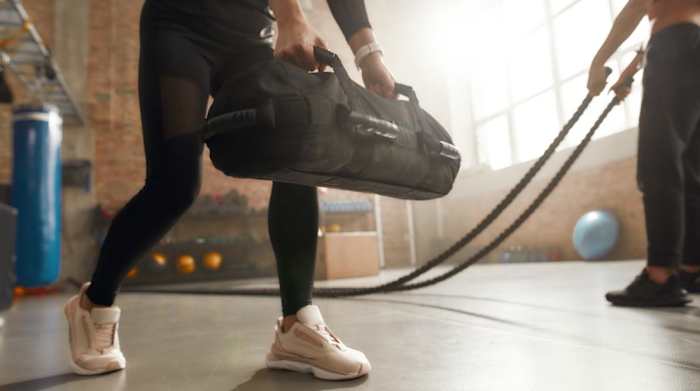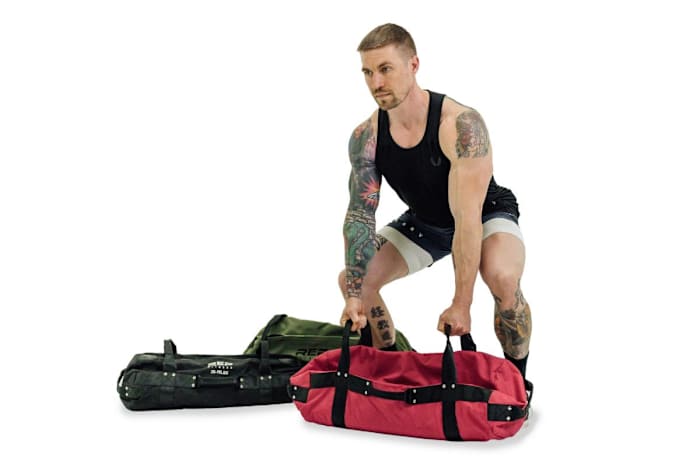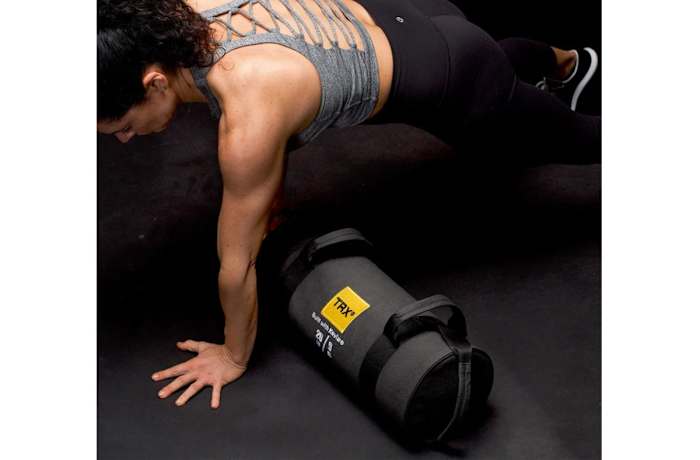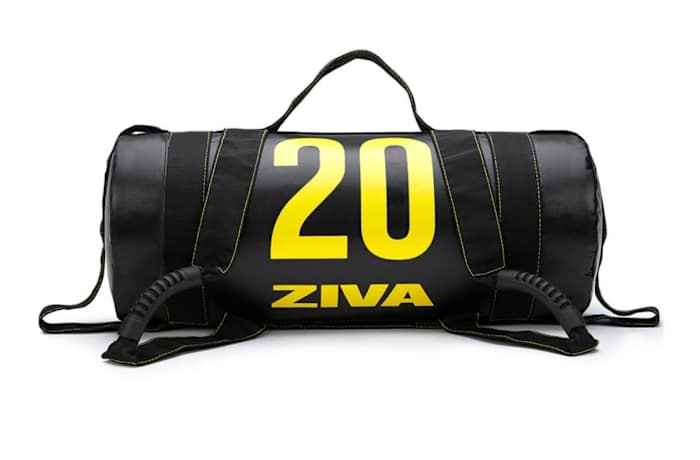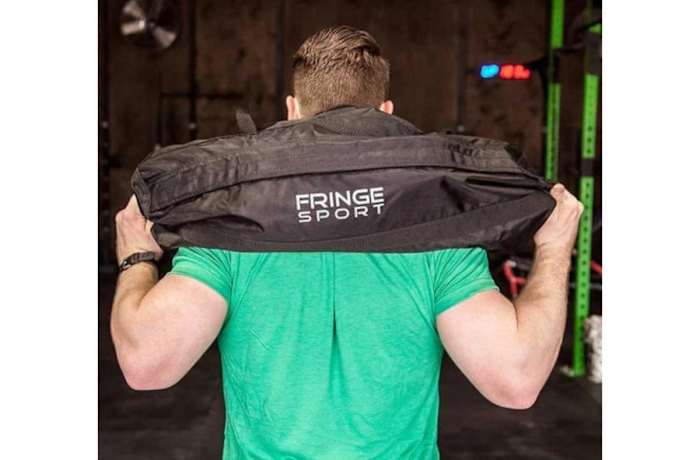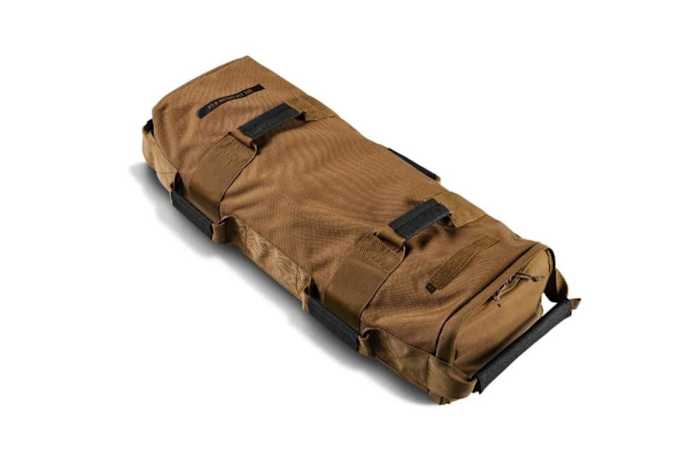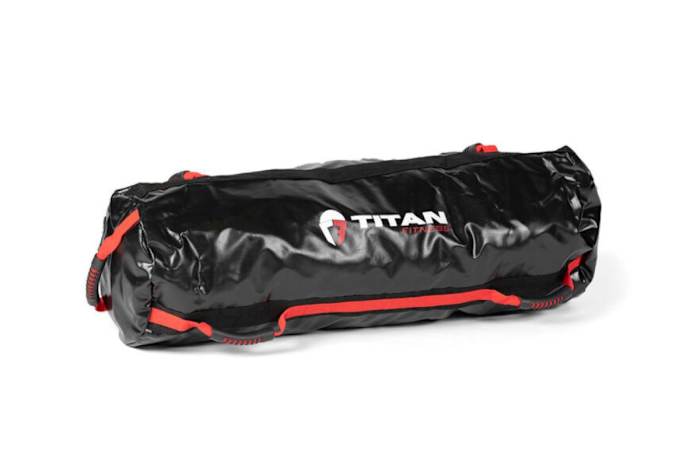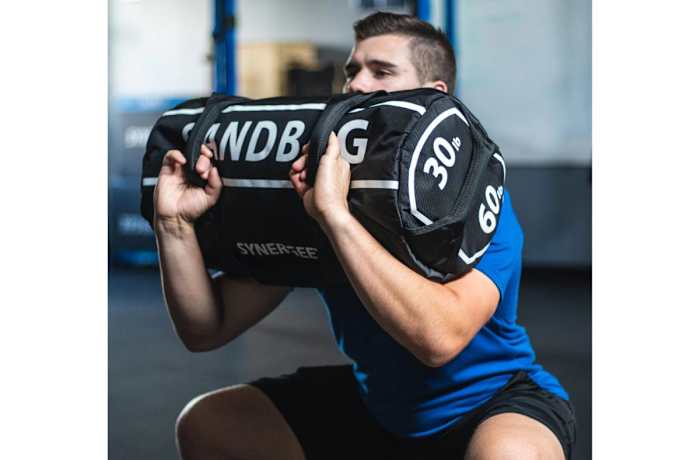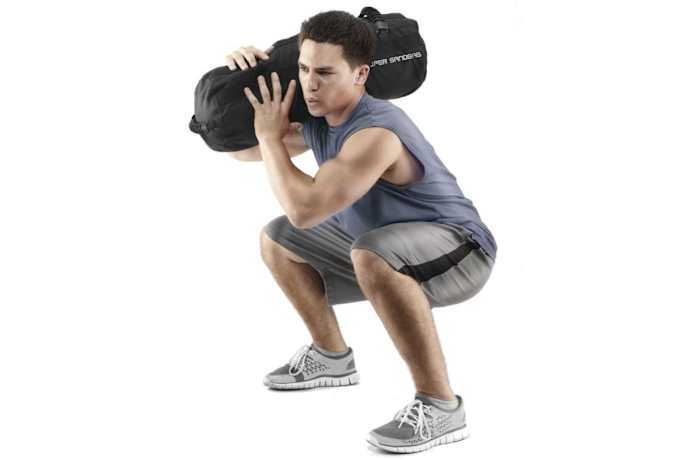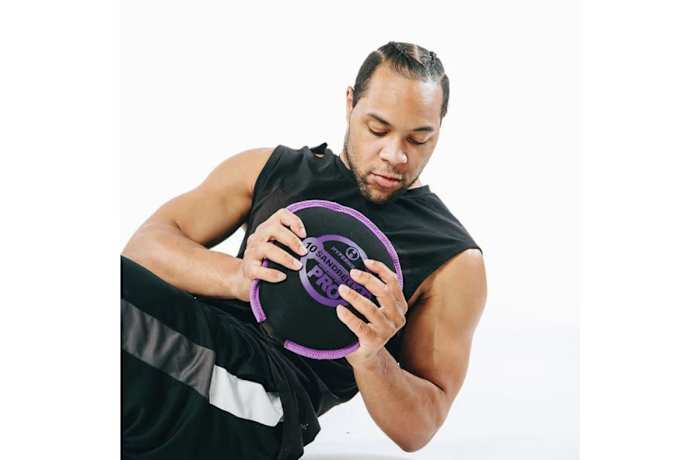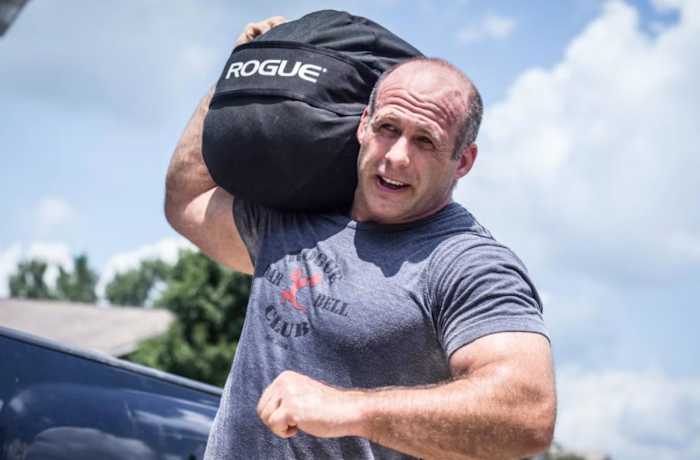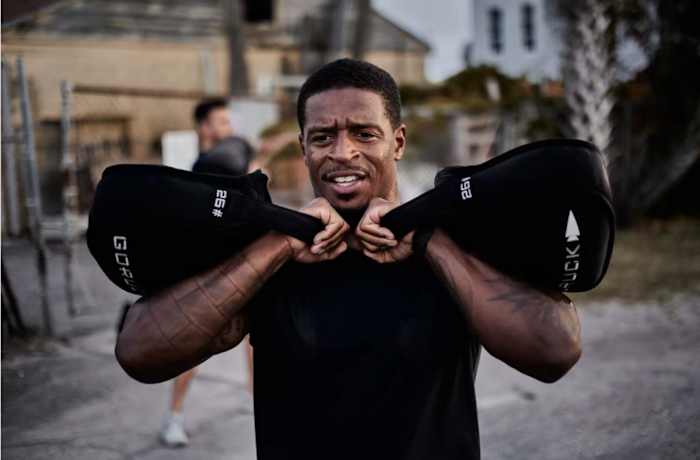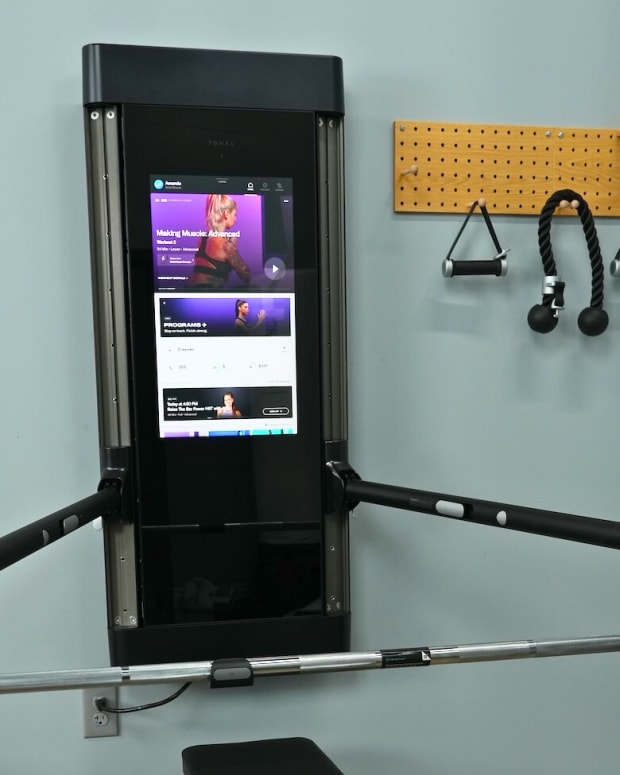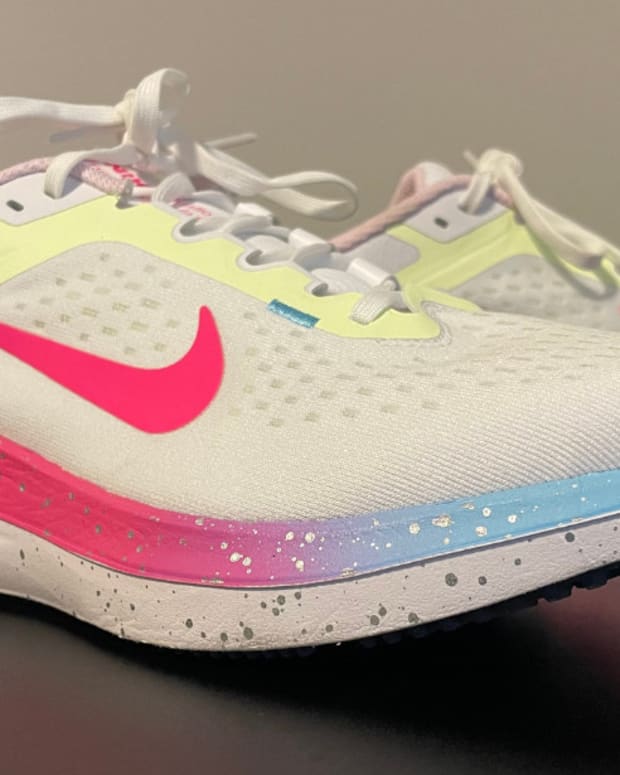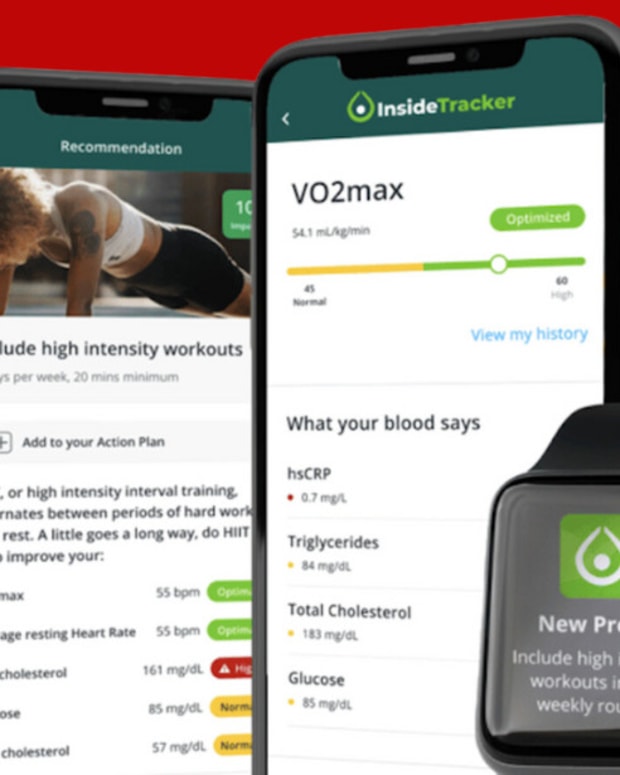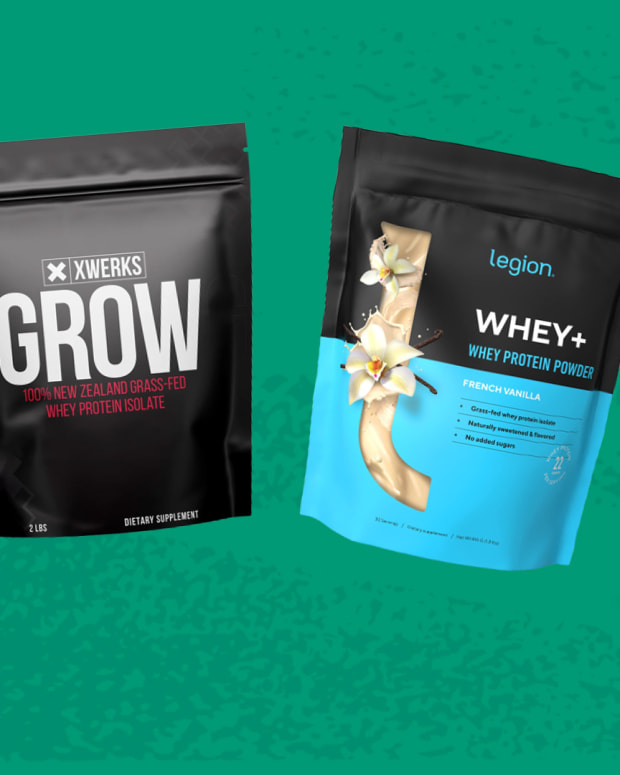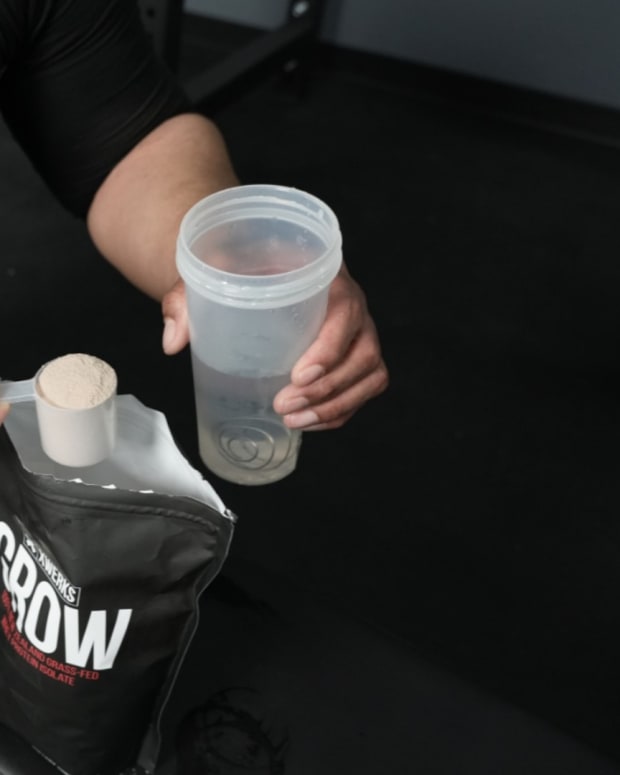The products featured in this article have been independently reviewed. When you buy something through the retail links on this page, we may earn commission at no cost to you, the reader. Sports Illustrated editorial staff are not involved in the creation of this content. Learn more here.
A fitness sandbag is a great way to change up your home workouts. The unstable weight distribution of the sand challenges your body differently than kettlebells, dumbbells, weight plates or barbells. Sandbags are a form of functional fitness that prepares you for real-world situations, like moving furniture or carrying 25-pound bags of flour from the car to your house. Even pros can find themselves tested when sandbags are involved. Adding one or two to your home gym can prepare you for a CrossFit competition or simply work your muscles in functional ways to better tone your body.
They're are made in different shapes, sizes, handle configurations and filler bags. Some models have multiple handle configurations and can potentially be used for exercises like squats, deadlifts, overhead presses and bench presses, to name a few. Each of these features will affect how you train, so you’ll need to have an idea of what you want to do with the sandbag before you buy. We’ve researched designs, specs and professional and customer reviews to create a list of the best sandbags for your home gym. A comprehensive shopping guide is also included to help you determine the style, weight and shape that will best meet your fitness goals in 2023.
Our Picks for the Best Sandbags of 2023:
- Best Overall Workout Sandbag: REP Fitness Sandbags
- Most Durable Workout Sandbag: TRX XD Kevlar Power Bags
- Best Workout Sandbag for Core Strength: Ziva Performance Power Core Bag
- Best Workout Sandbags for Squats: Fringe Sport Sandbag Trainer System
- Most Versatile Workout Sandbag: 5.11 PT-R Weight Kit Sandbag
- Best Sandbag for Grip Strength: Onnit Sandbag
- Best Budget Workout Sandbag: Titan Fitness Weight Training Sandbag
- Best Workout Sandbag with Handles: Synergee Weighted Sandbags V2
- Best Sandbag for Beginners: SKLZ Super Sandbag
- Best Pre-Filled Workout Sandbag: Hyperwear SandBell PRO
- Best Workout Sandbag for CrossFit: Rogue Fitness Strongman Sandbags
- Best Sandbag Kettlebell Alternative: GORUCK Sand Kettlebells
Best Overall Workout Sandbag: REP Fitness Sandbags
Key features and specs:
- Weight range: Five to 200 pounds (distributed among four sizes)
- Number of handles: Seven
- Dimensions: 20 inches long (five to 25-pound bag), 36 inches long (125-200-pound bag), width not available
- Materials: 1000D Cordura nylon
- Warranty: One year
- Price: $39.99-$89.99
The REP Fitness Sandbags enjoy a well-earned reputation for durability. They’re versatile and come with seven built-in handles, giving plenty of handholds for everything from overhead carries to deadlifts. The handles feature cross-stitched and triple-stitched seams with metal grommets and rivets that can handle the weight of the bag’s interior.
Made of tough 1000D Cordura nylon, these bags are designed to last. However, REP Fitness makes it clear that you shouldn't directly fill the shell—always use filler bags. Each sandbag comes with several smaller filler bags that let you adjust the weight by adding or removing bags without emptying the sand. The filler bags are extremely secure to reduce the possibility of leaks. One Amazon reviewer said about the filler bag closures, “It's super strong velcro that is inside the bag, then folds over to make a crease, then has more velcro to close it again. No way there is any sand coming out of these.”
The REP Fitness Sandbags come in four sizes: five to 25 pounds, 25-75 pounds, 75-125 pounds and 125-200 pounds. They range in length from 20 inches for the smallest bag to 36 inches for the largest bag. Keep in mind that REP Fitness recommends filling the bags to 70 percent of capacity to prevent burst seams. And promisingly, we found only one complaint on Amazon about a grommet coming out.
Pros:
- Strong seams and reinforced handles
- Versatile handle configuration
- Durable fabric and construction
- Excellent price for the durability
Cons:
- Grommets may come off
Most Durable Workout Sandbag: TRX XD Kevlar Power Bags
Key features and specs:
- Weight range: 10-60 pounds
- Number of handles: Five
- Dimensions: 21-25 inches long x eight to 10 inches wide
- Materials: Kevlar, nylon
- Warranty: Two years
- Price: $159.95-$299.95
TRX may be best known for its suspension trainers, but the TRX XD Kevlar Power Bags are impressive in their own right. They get the title of most durable sandbag thanks to the Kevlar exterior. Yes, it’s the same Kevlar material used to make bulletproof vests. Five nylon webbing handles with cross stitching provide the grip to match the durability of the exterior.
These bags come pre-filled in 10-, 15-, 20-, 24-, 30-, 35-, 40-, 45-, 50- and 60-pound weights. A reviewer on TRXTraining.com says, “Weight is balanced with very little to no shifting. Strong too!” They’re expensive, but keep in mind that you don’t have to buy sand or fill the sandbag yourself.
Pros:
- Durable Kevlar for indoor or outdoor use
- Pre-filled, so you can start using them right away
- Many weight increments available
Cons:
- Expensive
- Weight isn’t adjustable
Best Workout Sandbag for Core Strength: Ziva Performance Power Core Bag
Key features and specs:
- Weight range: 10-50 pounds
- Number of handles: Seven
- Dimensions: Not listed
- Materials: PVC, non-slip grips
- Warranty: None (30-day return period)
- Price: $59.99-$89.99
The Ziva Performance Power Core Bag is a pre-weighted sandbag, which takes some of the work out of your hands because you don’t need to add sand. Each bag has seven grips/handles with a textured rubber cover. The varied positioning of the handles provides versatile cardio and strength training options by engaging core muscles in different ways throughout your workout.
A commercial-grade PVC shell with double-stitched seams and handles creates excellent durability. Plus, the shell is easy to wipe clean. The Ziva is available in seven weights: 10, 15, 20, 25, 30, 40 and 50 pounds. However, there are a couple of downsides. First, the rubber on the handles can be uncomfortable for some users, according to Amazon reviews. Plus, there’s no warranty. You can return the bag within 30 days, but that’s the extent of the coverage, as explained in the online warranty coverage.
Pros:
- Pre-filled so you can start working out immediately
- Seven weight options
- Easy clean PVC exterior
- Seven handles
Cons:
- Rubber cover on handles can be uncomfortable
- Dimensions aren’t available
- No warranty
Best Workout Sandbags for Squats: Fringe Sport Sandbag Trainer System
Key features and specs:
- Weight range: 10-100 pounds
- Number of handles: Four
- Dimensions: Small is 25 inches long x eight inches wide, large is 30 inches long x 10 inches wide
- Materials: Cordura nylon
- Warranty: One year
- Price: $52-$100
The Fringe Sports Sandbag Trainer System comes in two sizes—small and large—with the small holding up to 60 pounds and the large holding up to 100 pounds. You can buy the sandbag, which Fringe Sports calls a trainer, alone, or for an additional price, you can buy filler bags in increasing weight increments up to 100 pounds. That lets you adjust the weight by adding or taking out filler bags.
The Fringe Sandbags have only four handles. However, that minimal handle design is what makes them the best sandbags for squats. You can rest the bags on your shoulders without extra handles pressing into the skin or getting in the way.
The trainers are made of heavy-duty Cordura nylon with a strong YKK zipper. Double-stitched seams and box-stitching at high-stress points give them impressive durability. Make sure to fill the filler bags to about 70 percent capacity to prevent leaks. Some users on Fringesport.com report that the filler bags can leak even when not filled to capacity, but the Fringe trainers come with a one-year warranty protecting against manufacturing defects.
Pros:
- Fewer handles for more comfortable squats
- Adjust weight by adding or removing filler bags
- Durable materials and construction
Cons:
- Filler bags may leak if dropped or slammed
Most Versatile Workout Sandbag: 5.11 PT-R Weight Kit Sandbag
Key features and specs:
- Weight range: Up to 100 pounds
- Number of handles: Eight
- Dimensions: 7.75 inches high x 28 inches long x nine inches deep
- Materials: 1050D nylon
- Warranty: Lifetime with exemptions
- Price: $165
The 5.11 PT-R Weight Kit Sandbag gets the most versatile award for the eight handles and hardware-free design. The handles have a non-slip design to give you a better grip, and the lack of hardware reduces the potential for discomfort or injury. The two fill bags that come with the PT-R also add to its versatility. The two bags have wrap-around nylon webbing with hook and loop closure handles so they can also be used in sandbag training. They can slide into the single-sided opening of the sandbag or be used on their own for farmer’s carry or in place of a kettlebell.
The sandbag’s closure has a protective zipper flap, reducing the chances of scratches or other injuries from the zipper. A thick, durable 1050D nylon is used for the exterior, while nylon webbing handles with reinforced seams and cross-stitching complete the design. This is a tough sandbag that’s really a two-for-one deal because of the option to use each filler bag as a weight bag. On the downside, the only way to adjust the weight of the filler bags when using them alone is by removing or adding sand, which can get cumbersome.
Pros:
- Durable materials and construction
- Eight handles
- Fill bags can be used as fitness sandbags too
Cons:
- Have to empty and refill filler bags to adjust their weight
Best Sandbag for Grip Strength: Onnit Sandbag
Key features and specs:
- Weight range: 60 pounds with filler bags
- Number of handles: Four
- Dimensions: 9.8 inches high x 25 inches long x 9.8 inches deep
- Materials: Oxford fabric
- Warranty: 90-day return policy
- Price: $82.85
The Onnit Sandbag, like a few others on our list, has only four handles. That’s because Onnit recommends grabbing the actual bag for the majority of your lifts to improve grip strength. The few handles this sandbag does have are seriously reinforced. They’ve been load tested with the side handle bearing 347 pounds and the top handle bearing 408 pounds. The maximum weight limit for the bag is 60 pounds, so you’ll never get near those numbers, but it’s good to know it’s strong. A tough exterior shell can also withstand the wear and tear of heavy use.
Each bag comes with two inserts, each capable of holding 30 pounds, that close with two layers of hook and loop material. You can adjust the weight by removing some of the sand or removing one of the filler bags. The only feature we don’t love is the 90-day return policy.
Onnit also makes the HydroCore Bag, which is like a sandbag, except it's filled with water. Similar to sand, water moves in such a way that it perpetually challenges the core muscles. Check out the Onnit HydroCore Bag if you don’t want the hassle of sand.
Pros:
- Durable fabric that withstands direct grabbing and pulling
- Reinforced handle design
- Adjustable weight
Cons:
- 90-day return policy in lieu of warranty coverage
Best Budget Workout Sandbag: Titan Weight Training Sandbag
Key features and specs:
- Weight range: 40-100 pounds
- Number of handles: Six
- Dimensions: Varies by bag size; filler bags measure 7.75 inches wide x 12 inches high
- Materials: Polyurethane leather
- Warranty: One year
- Price: $44-$64
The Titan Weight Training Sandbag has budget-friendly price points and comes in four sizes: 40, 60, 80 and 100 pounds. The sandbag comes with filler bags that each hold up to 10 pounds—the 40-pound model comes with four, the 60-pound with six and so forth. You can remove or add filler bags to adjust the weight.
An exterior made of polyurethane leather and reinforced zippers with hook and loop closures keep the filler bags and their contents contained. Each bag has six soft-grip rubber handles to vary positioning and grip. The filler bags don’t create a snug interior, so expect some sliding within the sandbag. That instability will increase the intensity of the workout; however, as reported in reviews on Titan.fitness.com, the seams can be a weak spot.
Pros:
- Affordable price
- Four sizes available
- Multiple filler bags with each sandbag
Cons:
- Seams can loosen or split with heavy use
Best Workout Sandbag with Handles: Synergee Weighted Sandbags V2
Key features and specs:
- Weight range: Maximum 40-60 pounds, depending on sandbag size
- Number of handles: Six
- Dimensions: Not listed
- Materials: Nylon Cordura
- Warranty: Three years
- Price: $59.95-$69.95
The Synergee Weighted Sandbags V2 have an integrated handle design that improves durability. An outer shell made of waterproof nylon Cordura and triple stitching in the shell and fill bags keep the handles and the rest of the seams secured. As one reviewer on SynergeeFitness.com put it, “I've been throwing this thing all over the place and not a stitch has loosed anywhere and no leaks at all, not even from either of the filler bags.” However, with heavy use, some users have noted stitches coming loose, but without any leakage.
This sandbag comes as either a 40-pound max model or a 60-pound max model. Both come with two filler bags, though the filler bags arrive empty, so you’ll have to purchase the sand separately. The filler bags have hook and loop closures, making it easy to adjust the weight based on your goals and fitness level.
Pros:
- Triple stitched for added durability
- Waterproof exterior
- Affordable price
Cons:
- Stitches may come loose with heavy use
Best Sandbag for Beginners: SKLZ Super Sandbag
Key features and specs:
- Weight range: 40 pounds
- Number of handles: Six
- Dimensions: 24.5 inches long x 12.5 inches wide
- Materials: Nylon
- Warranty: One year
- Price: $59.99
Beginners need a bag that’s not too expensive and allows them to adjust the weight as their strength increases. The SKLZ Super Sandbag does just that. It comes with four filler bags that each hold 10 pounds. A sturdy nylon exterior and vinyl filler bags can take heavy use as long as you don’t slam the sandbag.
With six handles, newbies can try different exercises to challenge their muscles in new ways. However, as one Amazon reviewer puts it, “The outer bag material feels abrasive so there may be a need to get used to this or somehow learn to avoid rubbing one's skin against it for certain exercises.”
Pros:
- Four filler bags let beginners slowly increase weight
- Six handles for versatile holds
- Affordable price
Cons:
- Abrasive exterior
Best Pre-Filled Workout Sandbag: Hyperwear SandBell PRO
Key features and specs:
- Weight range: Six to 70 pounds
- Number of handles: None
- Dimensions: Varies by weight
- Materials: Neoprene
- Warranty: 12 months
- Price: $27.99-$157.24
The Hyperwear SandBell PROs are round discs that come prefilled with weights ranging from six to 70 pounds. Color-coded trim and the weight printed on both sides make it easy to identify which bell you need from across the room. The shell is made of water-resistant neoprene with Silvadur, an antimicrobial fabric to prevent germ buildup. Neoprene is a softer material, so the bells move in your hands, exercising your grip strength and activating support and balance muscles as you workout. The soft fabric also won’t damage the floor of your home gym.
A user that’s fairly new to using weights said on Hyperwear.com, “They are somewhat dynamic and force me to get a tight grip. I like that I can do different exercises without worrying about damaging the floor.” Another says, “My favorite way to lift weights. It works your core, your wrists, your hands, your triceps, or biceps…lay it on your abs [and] do your ab work; just so much that you can do with the sandbags.”
Pros:
- Antimicrobial and water-resistant neoprene
- Many weights to choose from
- Suitable for indoor and outdoor use
- Color-coded trim and visible weight number on both sides
Cons:
- No handles
- Weight isn’t adjustable
Best Workout Sandbag for CrossFit: Rogue Fitness Strongman Sandbags
Key features and specs:
- Weight range: 25-400 pounds
- Number of handles: None
- Dimensions: 11.5-16 inches wide x 4.5-36 inches high
- Materials: 1000D Cordura
- Warranty: Three years
- Price: $60-$140
Rogue Fitness is a well-known brand in the weightlifting community, and the Rogue Strongman Sandbag lives up to the Rogue reputation. These sandbags are made of highly durable 1000D Cordura with double-stitched seams. Unlike many of the other sandbags on our list, these bags have a non-removable, built-in liner. You put the sand directly in the sandbag and seal it with a heavy-duty zipper covered by a hook and loop strap. (The strap should not be used as a handle.)
The cylindrical shape can work your grip, core, back, arm and leg strength in ways other sandbag shapes with handles don’t. Please note that these bags are not meant for slams, and the fabric may stretch over time. Some users on RogueFitness.com report that the seams can stretch, though they don’t break thanks to the double stitching. However, there is that potential.
Pros:
- Wide size and weight range
- Built-in filler bag
- Zipper with hook and loop cover strap
Cons:
- Threads may pop around seams
Best Sandbag Kettlebell Alternative: GORUCK Sand Kettlebells
Key features and specs:
- Weight range: 13-53 pounds
- Number of handles: One per kettlebell
- Dimensions: Two to 8.75 inches length x 8.5-9.75 inches width x 9.25-10.5 inches high
- Materials: 1000D Cordura
- Warranty: Three years
- Price: $39-$59
GORUCK Sand Kettlebells differ from standard kettlebells because the weight shifts as you move, which challenges your balance and support muscles. Made of 1000D Cordura and double stitched, these kettlebells can handle heavy use. Each handle has neoprene padding and a reinforced ballistic bottom for extra abrasion resistance. You can customize the weight, but each kettlebell has a maximum weight limit that falls between 13-53 pounds.
An interior filler funnel makes it easier to fill the kettlebell. The interior also has a hook and loop closure that’s further secured with a YKK zipper on the exterior to reduce the possibility of a leak. GORUCK also makes an impressive traditional sandbag—the GORUCK Sandbag 2.0. It has 12 handles with reinforced neoprene padding, double-stitched seams and heavy-duty materials and zippers, making it a bit higher-end than most traditional sandbags.
Pros:
- Multi-step closure system keeps sand inside the bag
- Abrasion-resistant bottom
- Padded handle
Cons:
- Not as versatile as other sandbag designs
Why You Should Add a Sandbag to Your At-Home Workout
Your body tries to maintain a baseline body mass even when you’re working to add muscle or lose weight. To maintain that baseline, your body can hit a dreaded plateau because it adapts to training tools that you use regularly. Sandbags are one way to keep your muscles guessing and create a body that’s prepared for everyday life. Your body can adapt to sandbags just like it can other exercise equipment, so your best bet is to alternate your exercise equipment. Use sandbags for four to six weeks, and then use dumbbells or kettlebells for six weeks. Plus, alternating your workouts can keep you from getting bored.
Sandbags also challenge the body in different ways than barbells, ankle weights, dumbbells or kettlebells. Sand inherently creates instability that pushes your stability, balance and strength. You end up activating your stabilizer and mover muscles at the same time. Sandbags also activate muscles involved with grip strength, like muscles in the hands, wrists and forearms.
How to Properly Use a Sandbag
Sandbags can be used for high-intensity interval training (HIIT), circuit training, strength training and functional fitness, just to name a few. In some respects, you use sandbags like you do other kinds of weights. The difference is in the shape of the bag and the instability of the sand. For example, if you do squats with a sandbag, you can hold the bag in front of you or behind you like a barbell; the sand will shift as you move, causing you to activate core and stabilizer muscles, as well as the major muscles in the lower and upper body.
Some sandbags have several handles you can use to lift, pull or carry the bag to get a full-body workout. Others, like those designed for Strongman exercise, may not have any handles. Others are designed to be carried by the shell fabric itself.
As with any exercise, it’s important to protect your back. You’ll need proper form when doing overhead lifts, squats and other exercises that can injure the lower back, shoulders, elbows and joints. Take the time to learn the proper form before performing sandbag exercises, like lifting with your legs and keeping weight close to your body. Good form will let you take full advantage of an intense HIIT or strength training session with a sandbag without injury.
How to Choose the Best Workout Sandbag For You
Purpose
Everything from where you use the sandbag (indoors or outdoors) to how often you use it and the type of exercises you’re doing ultimately affects the type of sandbag that’s best for you. If you use the bag outside, you need a model with some water resistance or waterproofing in the shell. If you’re training for CrossFit or Strongman, a model designed for standard carries without any handles is a good choice. Or you can use a standard sandbag with handles—just don’t use them in practice.
Those using the sandbag in their home gym need to think of their storage space. Consider a smaller model or one with removable sand, since those options won’t take up too much room. Also keep in mind that a sandbag can replace a set of dumbbells or multiple kettlebells.
Materials
Sandbags have to be tough and durable. The best materials to look for are nylon, polyester, neoprene and Cordura, which can be made of either nylon or polyester. Cordura is one of the toughest materials used to make sandbags—it’s also used to make combat boots for the military! You’ll often see Cordura measured in denier (D). The thicker the fabric, the higher the denier number. Models with 1000D or higher will offer some of the best durability. However, high-quality or military-grade Cordura can be expensive. Other materials like nylon, polyester and neoprene can perform well, but consider that you may not be able to slam or throw them like you could a sandbag made with high-denier Cordura.
Filler bags
Filler bags are the inner bags that hold the sand inside the shell. They’re typically made of nylon, vinyl or polyester and feature multiple closure methods to prevent leaking. Common closure designs include a double hook and loop and also zippered closures with hook and loop straps over the top.
Filler bags come either pre-filled or unfilled. Pre-filled bags are ready to go from the time they arrive and have a set weight (ex: 15 pounds). Usually, you can’t adjust the weight of a pre-filled bag. Unfilled bags typically cost less, but you have to buy the sand and fill the bag yourself. You also have to weigh your filler material to make sure you aren’t overfilling the bag. Unfilled bags often come with a shell that can hold several filler bags. That way, you can adjust the overall weight by removing or adding filler bags.
Handles
Handle material and design make a big difference, too. Nylon webbing, like a seatbelt, is one of the best options. It’s durable, but soft on the hands. Some sandbags have rubber grip handles to add texture for a stronger grip, though the rubber can hurt your hands with any kind of twisting motion.
Handles go through a lot on a sandbag, so look for models with double and triple stitching for added durability. Also take a good look at the handle placement before you buy. Sandbags may have zero to eight handles, depending on the sandbag’s purpose and design. Handles on the short end of the bag are typically used for pulling exercises. Handles arranged vertically and horizontally along the long side of the bag can be used for various lifting activities.
Related: Best Weight Lifting Straps for Deadlifts, Powerlifting and More
Shape
Sandbags come in a surprising number of shapes. The most common is a cylindrical shape that looks like a duffle bag. This shape is often the most versatile because you can pull, lift and swing it. Other shapes include square, conical and kettlebell. The shape alters the weight distribution and will challenge your muscles in different ways. However, for general use, the standard duffle bag type is often the most versatile.
Strongman and CrossFit sandbags are a little different. They’re cylindrical, but they don’t have handles. They require a strong grip or locking the arms around the circumference of the sandbag so it can be carried, thrown or lifted.
Size
Sandbags come in many different sizes and can be anywhere from a few inches tall with a 12-inch diameter to 36 or more inches long. Bigger bags allow you to add more weight, but if you’ve got limited space, a smaller bag can conserve space.
Weight capacity
Every sandbag has a maximum weight capacity that shouldn’t be exceeded. If you overfill the bag, the seams can leak or burst. Weight capacities typically fall between five and 150 pounds. However, there are many sandbags designed for higher weights, including those that can hold 400 pounds or more for Strongman training and competitions.
Durability
Durability comes down to the sandbag’s construction and materials. We’ve already discussed the materials. When looking at construction, you want a sandbag with double or even triple-stitched seams, especially for models designed for throwing or slamming. Some models may have reinforced zippers and hook and loop closures over openings to improve durability.
Price
Sandbags come in a wide price range that’s surprisingly affordable on the cheaper end—starting prices are around $45-$50. At the high end of the price range are ultra-durable sandbags with high weight capacities of over 250 pounds. These bags typically cost at least $150, and sometimes can reach prices as high as $250.
Consider what you need before investing in a sandbag. A sandbag that gives you room to improve often provides the best bang for your buck. For example, a sandbag that comes with four filler bags, each holding 10 pounds, gives you some room for improvement if you can already handle 20 pounds.
Sandbag FAQs
What is the best sand to use in sandbags?
Most hardware stores carry plaster or mason sand at a reasonable price. Keep in mind that some sands are denser than others, so you may reach the sandbag’s maximum weight limit with a relatively small or large amount of sand, depending on the sand’s density. Also, make sure the sand is clean and dry. Wet sand can mold and mildew in the bag, ruining it.
How long will a sandbag last?
A sandbag’s lifespan depends on how heavy it is, how often it’s used and the quality of the materials and construction. A high-quality sandbag with dry, clean sand that’s used regularly should last several years. However, if you slam or throw an exercise sandbag that’s not designed for that use, it could leak within a few months. You’ll get the longest use by using the sandbag as recommended by the manufacturer.
What is the easiest way to fill sandbags?
Place the filler bag on a sturdy surface, and slowly pour the sand into the bag until it’s reached your desired weight. (Some people like to weigh out their filler before pouring.) Many filler bags have a fill line on the interior. Do not fill past this line as it can cause a leak. If you have trouble, try using a large funnel. Once the sand is inside the bag, follow the manufacturer’s instructions to seal it.
How heavy of a sandbag should I get?
The sandbag weight you need depends on your physical fitness and strength. A beginner can typically start with a 20- to 40-pound sandbag, while a more experienced athlete can start with a 40- to 60-pound bag. Keep in mind that if you’re consistent, you’ll need heavier bags over time.
What size sandbag should I start with?
Take into account the size of your home gym, storage space, fitness goals and strength. The sandbag should be big enough that the weight challenges you. At the same time, it shouldn’t be so big that it takes up the majority of your gym space.
Should sandbags be used inside or outside?
Some sandbags are designed for exclusive use inside or outside, while others can be used in both places. A model designed for outside use should have a water-resistant or waterproof shell. It might also have a reinforced bottom to withstand the extra friction of use on rough ground or concrete.
Final Thoughts
A workout sandbag is great for building strength, saving space and improving your cardiovascular fitness. Keep your goals in mind as you choose a sandbag. A sandbag that leaves you room to grow can become an integral part of your training program. Get a model with plenty of handles if you want to use the bag to replace other fitness equipment like dumbbells or kettlebells. If you’re a more specialized weightlifter, you might want to invest in your own Strongman bags. Either way, you’re going to get a great workout.
Prices are accurate and items in stock as of publish time.
